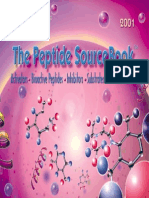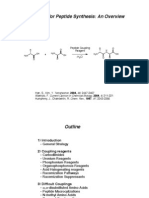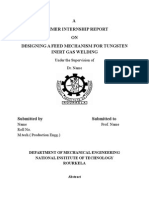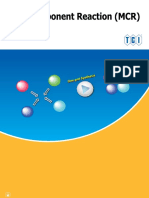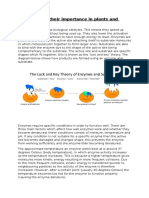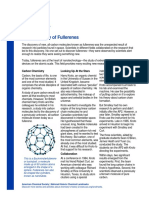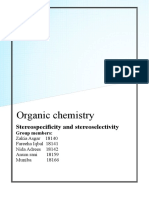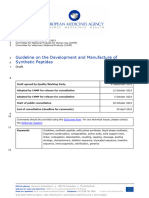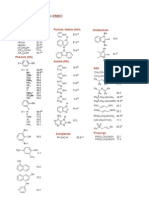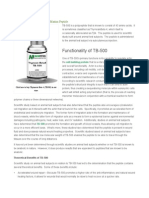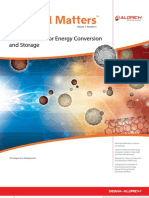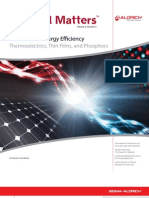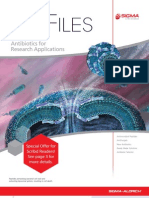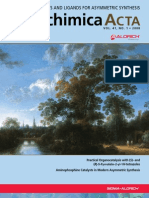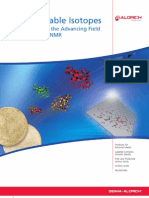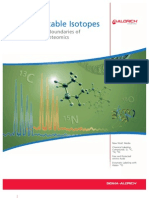Chemfiles Vol. 10, No. 4
Chemfiles Vol. 10, No. 4
Uploaded by
Sigma-AldrichCopyright:
Available Formats
Chemfiles Vol. 10, No. 4
Chemfiles Vol. 10, No. 4
Uploaded by
Sigma-AldrichCopyright
Available Formats
Share this document
Did you find this document useful?
Is this content inappropriate?
Copyright:
Available Formats
Chemfiles Vol. 10, No. 4
Chemfiles Vol. 10, No. 4
Uploaded by
Sigma-AldrichCopyright:
Available Formats
Aldrich
Volume 10, Number 4 • 2010
Asymmetric Synthesis
Catalysis
Chemical Biology
Organometallics
Fe(S,S-PDP) - an electrophilic iron catalyst for site-selective C-H oxidation
Building Blocks
Synthetic Reagents
Stockroom Reagents
Labware Notes
Chemistry Services
74511 ChemFiles 10.4_home.indd 1 10/28/2010 10:25:06 AM
Do not miss out on the latest research
developments in chemistry!
Aldrichimica Acta is a complimentary quarterly publication, which has been an international forum for the
frontiers of chemical research for the past 43 years. Articles, written by chemists from around the world,
cover a variety of topics usually based on a synthetic theme involving organic, organometallic, bio-organic,
or inorganic chemistry. It has been ranked #1 by Impact Factor in eight of the past nine years in the field of
organic chemistry (out of over 50 similar journals), with an Impact Factor of 18.688 (2009).*
Aldrichimica Acta helps keep you informed of the latest research methodologies and trends, as well as the
related Aldrich Chemistry products to support them.
Request your FREE copy today by visiting aldrich.com/acta
Get your FREE subscription
to the Aldrichimica Acta
today at aldrich.com/acta
* Thomson Reuters; Journal Citation Reports®, Science Edition.
sigma-aldrich.com
74511 ChemFiles 10.4_home.indd 2 10/28/2010 10:25:15 AM
Aldrich
Introduction
Haydn Boehm, Ph. D.
Volume 10, Number 4 Global Marketing Manager: Chemical Synthesis
haydn.boehm@sial.com
Introduction
Sigma-Aldrich Corporation Dear Chemists
6000 N. Teutonia Ave.
Firstly I would like to offer congratulations from all
Milwaukee, WI 53209, USA
of us here at Sigma-Aldrich to Prof. Richard Heck
Editorial Team of the University of Delaware in Newark, US, Prof.
Haydn Boehm, Ph.D. Ei-ichi Negishi of Purdue University, US, and Prof.
Wesley Smith
Akira Suzuki of Hokkaido University in Japan, who were awarded the 2010
Dean Llanas
Sharbil J. Firsan, Ph.D. Nobel Prize for chemistry. These three pioneers of synthetic organic chemistry
Weimin Qian, Ph.D. were acknowledged for their eponymous palladium-catalyzed cross-coupling
reactions, which form new carbon-carbon bonds under mild conditions, and are
Production Team
now indispensable to both research laboratories and industrial processes around
Cynthia Skaggs
Carrie Spear the world.
Chris Lein Indeed this news has proven very timely as Prof. Negishi was our second speaker
Tom Beckermann in the new Aldrich Chemistry Webinars series, and his ZACA Reaction Webinar
Christian Hagmann
Denise de Voogd was broadcast live from the 5th Annual Negishi-Brown and CAOSS Lectures from
Purdue University on Tuesday, October 12, in partnership with the American
Chemistry Team Chemical Society and C&EN Webinars. If you were unable to attend the webinar
Daniel Weibel, Ph.D. then you can access it via aldrich.com/cheminars.
Josephine Nakhla, Ph.D.
Matthias Junkers, Ph.D. The cover molecule of our fourth edition of the new Aldrich ChemFiles is
Mark Redlich, Ph.D. Fe(S,S-PDP), which was originally reported by Prof. Christina White, and is now
Troy Ryba, Ph.D. available from Aldrich Chemistry as part of our chiral 2,2’-bipyrrolidines portfolio
Todd Halkoski
Paula Freemantle
(Asymmetric Synthesis). In Aldrich ChemFiles 10.4 we also introduce the latest
Mike Willis building blocks for chemical biology (Chemical Biology), PEMB for reductive
aminations (Synthetic Reagents), new gold catalysts (Catalysis), new organotins
Aldrich ChemFiles Subscriptions
and organozincs (Organometallic Reagents), and our new oxetane portfolio
To request your FREE subscription to Aldrich ChemFiles, either visit our
(Building Blocks).
website at: aldrich.com/chemfiles or contact your local Sigma-Aldrich
office (see back cover). I hope that Aldrich ChemFiles 10.4 keeps you informed of the new Aldrich
Chemistry products that facilitate the latest research methodologies and trends,
Aldrich ChemFiles Online
and allows you to access key starting materials and reagents more efficiently.
Aldrich ChemFiles is also available in PDF format on the Internet at
aldrich.com/chemfiles.
Aldrich Chemistry Products Thanks for reading,
Aldrich brand products are sold through Sigma-Aldrich, Inc.
Sigma-Aldrich, Inc. warrants that its products conform to the
information contained in this and other Sigma-Aldrich publications.
Purchaser must determine the suitability of the product for its
particular use. See reverse side of invoice or packing slip for additional
terms and conditions of sale. All prices are subject to change Haydn Boehm, Ph. D.
without notice.
To Place Orders or Contact Customer/
Technical Services Table of Contents
Please contact your local Sigma-Aldrich office (see back cover).
Asymmetric Synthesis ...............................................................................................................................4
Aldrich ChemFiles (ISSN 1933–9658) is a publication of Aldrich Chemical Catalysis ................................................................................................................................................................6
Co., Inc. Aldrich is a member of the Sigma-Aldrich Group. © 2010 Chemical Biology ....................................................................................................................................... 10
Sigma-Aldrich Co. Organometallic Reagents.................................................................................................................... 12
Building Blocks ............................................................................................................................................ 14
Synthetic Reagents ................................................................................................................................... 16
Stockroom Reagents ............................................................................................................................... 18
Labware Notes.............................................................................................................................................. 20
Chemistry Services ................................................................................................................................... 22
74511 ChemFiles 10.4_home.indd 3 10/28/2010 10:25:22 AM
On the basis of this set of selectivity rules the preferential oxidation
Asymmetric Synthesis of the electron-rich and sterically unencumbered tertiary C–H
Daniel Weibel, Ph.D. European Market
bond at C-10 of antimalarial tetracyclic compound (+)-artemisinin
Segment Manager, Chemistry (361593) was predicted. In addition to the site selectivity issue
posed in this substrate, a chemoselectivity challenge is present
daniel.weibel@sial.com in the form of a sensitive endoperoxide moiety known to be
Asymmetric Synthesis
prone to Fe(II)-mediated cleavage.3 (+)-10β-Hydroxyartemisinin
Chiral 2,2’-Bipyrrolidines was generated in diastereomerically pure form as the major
C2-symmetrical, chiral 2,2’-bipyrrolidines product in 54% yield (after recycling of artemisinin). Interestingly,
have recently emerged as interesting (+)-artemisinin (361593) has previously been transformed
structural chiral motifs in a number of enzymatically with microbial cultures of Cunninghamella echinulata
ligands for asymmetric transformations to 10β-hydroxyartemisinin in 47% yield with substantially longer
(Figure 1). When the two nitrogen atoms function either in a reaction times and a 10-fold lower volume throughput.3 The ability
bidentate chelate ligand or are covalently bonded to another of the simple, small molecule iron catalyst Fe(S,S-PDP) (730459)
atom, the two pyrrolidines adopted a stair-like structure, which with broad substrate scope to achieve P-450-like tailoring enzyme
creates a highly asymmetric environment. selectivities is remarkable.
H3C OH
H H H H CH3 H2O2
H H
H H
O O
N N N N H3C H3C
H H H H N N O O
O O
OH OH H H N
O H O H
HO2C HO2C CH3 N 2 NCCH3 CH3
CO2H CO2H 1.5• HO2C CO2H Fe (SbF6 )2
O O
OH OH
(+)-artemisinin N NCCH3 54%
N
688622 688746 712116
730459
Figure 1. Commercially available chiral 2,2’-bipyrrolidines.
Prof. Denmark has exploited this feature in the development of a Scheme 2: Selective aliphatic iron-catalyzed C–H oxidation
highly selective catalyst for asymmetric allylations.1 The addition of
Recently, Prof. White reported the same bulky, electrophilic
allylic trichlorosilanes to unsaturated aldehydes can be catalyzed
iron catalyst is capable of site-selective oxidation of isolated,
by chiral bisphosphoramide derived from 2,2’-bipyrrolidine (for the
unactivated secondary C–H bonds to afford mono-oxygenated
corresponding chiral bisphosphoramide catalyst derived from
products in preparatively useful yields without the use of directing
N,N′-dimethyl-1,1′-binaphthyldiamine, (715549) to give homo-
or activating groups (Scheme 3).4
allylic alcohols with excellent diastereo- and enantioselectivities
(Scheme 1). 730459 (15 mol %)
AcOH (1.5 eq) O
H H
EWG H2O2 (3.6 eq) EWG
n CH3 n CH3
H H CH3CN, rt, 30 min H H
H N O O N H O O O O O O CH3 O
P (CH2)5 P
H N N N N H CH3
CH3 CH3 H3CO CH3 H3CO H3CO CH3 H3CO CH3
O CH3
1. (5-10 mol %) 50% 51% 54% 43%
O Hunig's base, -78°C OH
R1 SiCl3
+
R H 2. NaHCO3, KF R CH2
R2 R1 R2 Scheme 3: Selective iron-catalyzed methylene oxidation
OH OH OH OH
In 2008, Prof. Lawrence Que developed an iron catalyst bearing
R CH2 R CH2 R CH2 R CH2
CH3 CH3 H3C CH3 the optically active 6-Me2-BPBP ((R,R)-1,1’-bis(6-methyl-2-
84-92%
80-88% ee
57-83% 54-91% 70-89%
88-96% ee
pyridinylmethyl)-2,2’-bipyrrolidine) ligand (712337) for asymmetric
anti/syn: 99/1 anti/syn: >95/5
81-86% ee (anti) 88-95% ee (syn) olefin dihydroxylation.5 This complex is hitherto one of the most
effective reported to date achieving up to 97% enantiomeric
Scheme 1: Highly selective asymmetric allylic allylations using a bisphos-
phoramide organocatalyst excess of the syn-diol product from cis-disubstituted olefins
(Scheme 4). These ee values are comparable to those obtained
In 2007, Prof. Christina White reported on an iron-based small with the osmium-based AD α or β mixes (392758 or 392766).
molecule catalyst Fe(S,S-PDP) (730459) bearing the (S,S)-1,1’-bis(2- These results demonstrate for the first time that a synthetic
pyridinylmethyl)-2,2’-bipyrrolidine (712361) moiety as chelating nonheme iron catalyst can approach the high enantioselectivity
ligand that uses hydrogen peroxide to oxidize a broad range of found in syn-dihydroxylating enzymatic systems.
substrates.1 Predictable selectivity is achieved solely on the basis
of the electronic and steric properties of the C–H bonds, without
the need for directing groups. This type of general and predictable
reactivity stands to enable aliphatic C–H oxidation as a method for
streamlining complex molecule synthesis (Scheme 2).
4 sigma-aldrich.com TO ORDER: Contact your local Sigma-Aldrich office (see back cover), or visit aldrich.com/chemicalsynthesis.
74511 ChemFiles 10.4_home.indd 4 10/28/2010 10:25:25 AM
Chiral 2,2’-Bipyrrolidines
N CH3
N 2 OTf H H H H
H H H
Fe
H
N OTf N N N N N N
H H H H H H
N CH3 OH OH
HO2C HO2C
CO2H CO2H 1.5• HO2C CO2H
Asymmetric Synthesis
2 mol % OH OH OH
35% H2O2 (10 eq)
R' R' ∗
R ∗ R'
CH3CN, rt, 20 min 688622 688746 712116
OH
OH OH OH O H H H H
∗ ∗ CH3 ∗ ∗ N
H3C ∗ CH3 H3C ∗ H3C OH H3C ∗ O CH3
N NCCH3 N N N N
OH OH OH OH 2
H
Fe (SbF6 )2
97% ee 96% ee 78% ee 76% ee H
N NCCH3 N N N N
N
• 4HCl • 4HCl
Scheme 4: Iron-catalyzed asymmetric olefin cis-dihydroxylation
References (1) Denmark, S. E.; Fu, J. J. Am. Chem. Soc. 2001, 123, 9488. (2) Chen, M. 730459 712353 712361
S.; White, M. C. Science 2007, 318, 783. (3) Zhan, J.; Guo, H.; Dai, J.; Zhang, Y.; Guo, D.
Tetrahedron Lett. 2002, 43, 4519. (4) Chen, M. S.; White, M. C. Science 2010, 327, 566. H H H H
(5) Suzuki, K.; Oldenburg, P. D.; Que, L, Jr. Angew. Chem. Int. Ed. 2008, 47, 1887.
N N N N
N N N N
CH3 H3C CH3 H3C
• 4HCl • 4HCl
712337 712345
For a complete list of bipyrrolidines available from Aldrich
Chemistry, please visit aldrich.com/bipyrrolidines
Let DiscoveryCPR Put High Throughput Back in Your Operation!
The Standard in Reagent Management for
Medicinal Chemistry and Organic Synthesis
Flexible | Efficient | Convenient
• Internet-based reagent database • Quick 48-hour turnaround time for
and procurement compounds and building blocks
• Powerful batch-search and • Reduce waste; eliminate
reporting capabilities on-site stocking and inventory
• Determine price and availability management
from your desktop • Specify vial type and labeling
• From micromoles to grams requirements, including bar-coding
• No minimum order required To register for an online ordering
account or to submit inquiries:
DiscoveryCPR DiscoveryCPR.com
Custom Packaged Reagents from Sigma-Aldrich puts high throughput back into your chemistry!
When projects demand custom arrays of reagents, DiscoveryCPR can meet the challenge.
Ready to scale up? For competitive quotes on larger quantities or custom synthesis, contact your local Sigma-Aldrich office, or visit safcglobal.com. 5
74511 ChemFiles 10.4_home.indd 5 10/28/2010 10:25:27 AM
Catalysis +
P Au NCCH3 SbF6
Josephine Nakhla, Ph.D.
Market Segment Manager
Organometallics & Catalysis R3 (2 mol %)
H3CO2C H3CO2C
H3CO2C
josephine.nakhla@sial.com H3CO2C CH2Cl2, rt
Catalysis
R3
H R1
R2 R2
R1
Alkyne Hydration H3CO2C H3CO2C
H3CO2C
H3CO2C H3CO2C
The hydration of alkynes has been R3
H3CO2C
CN NO2
H CH 3 H H
Ph H
extensively studied for more than
100 years. This reaction allows access
74% 58%
to various carbonyl derivatives from alkyne precursors. Nolan 78%
and coworkers reported alkyne hydration using a gold catalyst.
Nolan, a pioneer in the use of N-heterocyclic carbenes (NHCs)
O P AuCl
as ligands in various catalytic transformations with different
3
metals, developed conditions employing a gold-NHC complex (5 mol %) R
AgSbF6 (5 mol %) R
and silver hexafluoroantimonate for the hydration of alkynes R
R CH2Cl2, rt
(Scheme 1). It is important to note that an acid is not needed for
this transformation and the reaction was feasible at low catalyst PhO2S O
HO
loadings (10 ppm). PhO2S
94% 56%
N N
Scheme 2: Intramolecular cycloaddition of 1,3-enynes with alkenes
Au
Cl Reference (1) Nieto-Oberhuber, C.; Pèrez-Galán, P.; Herrero-Gómez, E.; Lauterbach,
(0.01 mol %) T.; Rodriguez, C.; López, S.; Bour, C.; Rosellón, A.; Cárdenas, D. J.; Echavarren, A. M. J.
O
AgSbF6
R1 R2 R1
R2 Am. Chem. Soc. 2008, 130, 269.
1,4-Dioxane/H2O (2:1)
120 °C, 18 h
O O O Propargyl Claisen Rearrangement
F
Toste and coworkers reported the use of the gold catalyst
H3CO [(Ph3PAu)3O]BF4 for the rapid two-step, one-pot sequence of a
88% 97% 72%
Claisen rearrangement of a propargyl vinyl ether followed by a
O O reduction of the resulting aldehyde functionality to provide a
O
variety of homoallenic alcohols. The reactions are generally high
76% 95%
yielding and the robust catalyst system is able to induce almost
complete chirality transfer (in most cases, ee’s were >90%). Low
Scheme 1: Hydration of alkynes using gold-NHC complex catalyst loadings (1 mol %) and substitution at the alkyne is well
Reference (1) Marion, N.; Ramón, R. S.; Nolan, S. P. J. Am. Chem. Soc. 2009, 131, 448.
tolerated generating the desired allenes in high yields (Scheme 3).
Reference (1) Sherry, B. S.; Toste, F. D. J. Am. Chem. Soc. 2004, 126, 15978.
Intramolecular Cycloaddition of 1,3-Enynes
BF4
with Alkenes
O
PPh3
Echavarren and co-workers employed a crystalline gold complex Au
Au Au
containing either the o-biphenyl phosphine ligand JohnPhos, Ph3P PPh3
(1 mol %) OH
or a bulky aryl ether phosphine under mild conditions to effect R1 O CH2Cl2, rt;
R3 •
the [4+2] cycloaddition of 1,3-enynes with olefins. A family of bi- NaBH4, MeOH, rt R1 R3
and tricyclic scaffolds were prepared in good yields (Scheme 2). OH OH OH
Both electron-withdrawing and electron-donating groups were • • •
H
tolerated on the aryl moiety. PivO
F3C
78% 81% 86%
Scheme 3: Preparation of homoallenic alcohols via Claisen rearrangement/
reduction sequence
6 sigma-aldrich.com TO ORDER: Contact your local Sigma-Aldrich office (see back cover), or visit aldrich.com/chemicalsynthesis.
74511 ChemFiles 10.4_home.indd 6 10/28/2010 10:25:33 AM
Gold Catalysts from Sigma-Aldrich
AuCl
Au N C CH3 AuCl
CH3
t-Bu P t-Bu P t-Bu P t-Bu
P AuCl H3C P AuCl
SbF6-
CH3
Catalysis
697575 254037 715050 679771 404217
i-Pr i-Pr
AuCl
H3C P CH3
H3C i-Pr
N N AuCl
P S AuCl P AuCl
CH3 H3C i-Pr
H3C i-Pr Au i-Pr
Cl
i-Pr
288225 420727 696277 687510 702749
O
P PPh3 BF4−
Au NaAuCl4 • 2H2O AuBr3 AuCl
1/ CH C H Au Au
O Au O 2 3 6 5 Ph3P PPh3
F3C S N S CF3
O O
677922 665142 298174 398470 481130
AuCl3 • AuCl3
N
334049 677876
Silver Salt Additives
O CF3
S O
O O
S OAg
Ag N AgSbF6 AgBF4 AgPF6 F3C S OAg
O
S O O
O H3C
CF3
668001 176427 227730 208361 227722 176435
For a complete list of Gold Catalysts available from Aldrich Chemistry, please visit aldrich.com/gold
Ready to scale up? For competitive quotes on larger quantities or custom synthesis, contact your local Sigma-Aldrich office, or visit safcglobal.com. 7
74511 ChemFiles 10.4_home.indd 7 10/28/2010 10:25:34 AM
Aldrich® Chemistry Webinars
Zirconium-catalyzed Asymmetric
Carboalumination of Alkenes (ZACA Reaction)
Your speaker for this Aldrich To watch a recording of this webinar, please visit
sponsored webinar is:
aldrich.com/ ZACAwebinar
Overview: Many, if not the majority, of the organic compounds that are of interest and
importance to mankind are chiral or optically active. Until recently, the major route to
such chiral compounds and biocatalysts was the biosynthesis performed by nature,
which employed enzymes as synthetic tools. Slowly but surely, other methods have
emerged and their significance was predicted to increase significantly during the 21st
century, when W. Knowles, R. Noyori, and K. B. Sharpless were awarded the 2001 Nobel
Prize for their pioneering research using non-biological asymmetric methods for C–H
and C–O bond formation.
What about the all-important C–C bond formation for asymmetric organic skeleton
Ei-ichi Negishi, Ph.D.
formation? This webinar introduces the discovery, development and application
H. C. Brown Distinguished
of the ZACA reaction, and showcases how its efficient, selective, potentially green
Professor of Chemistry
and economical syntheses of biologically and medicinally important chiral organic
Purdue University
compounds can benefit mankind.
Co-Winner of 2010
Nobel Prize in Chemistry R2
i) R23Al, Cat. (-)-(NMI)2ZrCl2
1 OH
R ii) O2 R1
Areas covered in the webinar:
R2 = Me, 68–92% yield, 70–90% ee
• Discovery and development of the ZACA (-)-(NMI)2ZrCl2=
R2 = Et, 56–90% yield, 85–95% ee
reaction R2 = Higher primary alkyl groups,
ZrCl2
2 74–85% yield, 90–95% ee
• Its application to efficient and selective
synthesis of chiral natural products
• Synthesis of vitamins (E, K, etc.) and other To view previous and future webinars, please visit aldrich.com/cheminars
compounds of dietary and medicinal interest
Hosted by:
Who should attend:
• Organic Chemists
• Medicinal Chemists
• Anyone involved in research in academic or
corporate labs
©2010 Sigma-Aldrich Co. All rights reserved. Sigma-Aldrich and Aldrich are trademarks belonging to Sigma-Aldrich Co. and its affiliate Sigma-Aldrich Biotechnology, L.P.
74511 ChemFiles 10.4_home.indd 8 10/28/2010 10:25:35 AM
Renewable and Alternative
Energy Web Portal
TM
Vol. 4, No. 4
Alternative Energy
Photovoltaics, Ionic Liquids
, and MOFs
The Portal offers a comprehensive set of links about
environmentally benign production, storage and
conversion of energy. Efficient Dye-Sensitized
Solar
• Solar Energy
Cells for Direct Conversion
of
Sunlight to Electricity
Organic Dyes for Efficient
Solar energy—the energy and Stable Dye-Sensitized
for everyone
Solar Cells
The Relentless Rise of
Disruptive Photovoltaics
Ionic Liquids for Energy
Storage Applications
Selected Applications
• Hydrogen Economy
of
Metal-Organic Frameworks
in
Sustainable Energy Technologies
72680_MM4-4_US_r7.
indd 1
• Batteries
12/3/2009 2:44:33
PM
Have you seen these
• Supercapacitors Material MattersTM issues
• Alternative Fuels on Alternative Energy?
• Relevant events and conferences are also highlighted. Get your complimentary
We focus on materials, so you can focus on results. For more information, subscription today:
visit sigma-aldrich.com/renewable sigma-aldrich.com/mm3
sigma-aldrich.com
74511 ChemFiles 10.4_home.indd 9 10/28/2010 10:25:44 AM
Proline Analogs
Chemical Biology Proline is a non-polar, natural amino acid that forms a tertiary
Matthias Junkers, Ph.D.
Product Manager
amide when incorporated into peptides. Thus, it is the only
proteinogenic amino acid that does not act as a hydrogen bond
matthias.junkers@sial.com donor in a peptide chain. Proline is known as a classical breaker
Chemical Biology
of both the α-helical and β-sheet secondary structures in proteins
New Building Blocks for and peptides, and it plays a crucial role in protein folding. Synthetic
proline derivatives, mimetics and analogs offer further options to
Chemical Biology tune the biological, pharmaceutical, or physicochemical properties
Modern automated synthesis protocols of peptides and proteins.
allow the fast and efficient production of
biopolymers like peptides and even proteins, or oligonucleotides. In recent years proline derivatives and analogs have also found
In recent years, even the automated synthesis of complex increasing popularity as organocatalysts in asymmetric synthesis.4
carbohydrates has been described.1 Automated synthesis
procedures build the bridge to Chemical Biology. It does not CH
O H2C O
require a fully trained chemist to perform automated synthesis. HC
O N
Even groups with a primary focus on biology research can utilize OH N OH
N Boc Boc
synthesizers to produce primers, test molecules, probes, etc., Boc
OH
quickly and efficiently. On the other hand, chemistry benefits 711985 711977 717045
equally from automated procedures. Synthesis challenges that
used to take weeks or months can today be completed in a matter O F O
of hours or a few days accelerating research tremendously. Fast N
N OCH3 OH
and efficient synthesis is only possible if all necessary tools are H Boc
readily available. Sigma-Aldrich is proud to offer a leading choice of 712884 717010
tools and building blocks for advancing science in the "omics" era
(genomics, proteomics, glycomics, metabolomics – to name just Unsaturated Amino Acids
a few). This issue of Aldrich ChemFiles highlights some examples of
recent additions to our portfolio. Recent developments in Chemical Biology research have increased
the demand of amino acid building blocks with unsaturated side
chains. Alkyne moieties can be used in bioorthogonal synthesis
Beta Amino Acids
strategies to form hybrid structures, introduce chemical probes into
Although they are less abundant than their α-analogues, biomolecules, or link large fragments with each other. The most
β-amino acids occur in nature both in free form and bound to prominent technique relies on the Huisgen dipolar cycloaddition
peptides. Oligomers composed exclusively of β-amino acids reaction between an azide and an alkyne.
(so-called β-peptides) might be the most thoroughly investigated
peptidomimetics. Besides being remarkably stable to metabolism, Olefin moieties open amino acids and peptides to metathesis
exhibiting slow microbial degradation, and inherently stable to reactions and a full range of other bioorthogonal synthesis routes.
proteases and peptidases, they fold into well-ordered secondary Olefin metathesis is a key to the production of hydrocarbon
structures consisting of helices, turns, and sheets. In this respect, stapled peptides.5 Stapled peptides are currently in discussion as
the most intriguing effects have been observed when β2-amino a new class of superpotent drugs or magical bullets promising
acids are present in the β-peptide backbone.2 A whole new to make peptide α-helices more potent and cell permeable by
“world” has emerged from the design of fascinating new peptidic locking them in the most active conformation.6
macromolecules from β- and γ-homologated proteinogenic amino
References: (1) Timmer, M.S.M.; Adibekian, A.; Seeberger, P.H. Angew. Chem. Int. Ed.
acids and other components. Sigma-Aldrich has a history as a 2005, 44, 7605. (2) Lelais, G.; Seebach, D. Biopolymers 2004, 76, 206. (2) Seebach, D.;
leading supplier of β3-amino acids. Now, the portfolio of β2-amino Beck, A.K.; Bierbaum, D.J. Chem. Biodiv. 2004, 1, 1111. (4) (a) Vignola, N.; List, B. J. Am.
acids is significantly increased with members that had not yet been Chem. Soc. 2003, 125, 450. (b) Dalko, P.I.; Moisan, L.; Angew. Chem. Int. Ed. 2004, 43,
5138. (5) Walensky, L.D. et al. Science 2004, 305, 1466. (6) Kritzer, A.K. Nature Chemi-
available commercially. cal Biology 2010, 6, 566.
10 sigma-aldrich.com TO ORDER: Contact your local Sigma-Aldrich office (see back cover), or visit aldrich.com/chemicalsynthesis.
74511 ChemFiles 10.4_home.indd 10 10/28/2010 10:26:00 AM
New Amino Acid Building Blocks Monosaccharides
N3 N3
CH3 O CH3 O O OH O O
HO OH
H3C OH H3C O O CH3 O
H3C OH H2N OH HO
• HCl • HCl O CH3
H2N NH2 O
NH2 NH2 OH • 2HBr HO
O
Chemical Biology
714135 714143 714119 714216 714224 725978
OH N3
O O
H O O
N OH O O
H2N OH Boc OH O O
Boc H3C H3C O O
O N O O
OH H H3C O CH3 H3C O CH3
OH
H3C H3C H
713821 OH OH
714127 713856
712167 712736 725862
O O
H
N OH O CH3 OH OAc N3
Boc OH
O N Boc O AcO O N3 HO O
N OBn OAc OH
Boc H OH
OBn OCH3 CN
OBn OAc OH
713848 713724 713813
712140 712817 712752
O O Boc
OH OH
NH For a complete list of building blocks available from Aldrich
N
Boc
N
Boc O Chemistry, please visit aldrich.com/chemprod
H H O
713864 713872 713473
O O O
Boc H2N
NH OH H2N OCH3 O
H3C CH3
• HCl
• HCl
670243 726273 726354
O O O
HC
H2N OH OH HC OH
HN HN HN
Boc Boc Boc
726230 712221 714240
O
NH2 O
HC OH • HCl
HN HC OH
Boc
714232 711926
Ready to scale up? For competitive quotes on larger quantities or custom synthesis, contact your local Sigma-Aldrich office, or visit safcglobal.com. 11
74511 ChemFiles 10.4_home.indd 11 10/28/2010 10:26:03 AM
New Boronic Acids and Boronate Esters—
Organometallics cont'd
Josephine Nakhla, Ph.D.
Market Segment Manager
H3C CH3
Organometallics & Catalysis CH3 H3C
CH3
H3C CH3 H3C
O O O H3C O
josephine.nakhla@sial.com B H3C
Organometallics
B H3C B N
N O
H3 C O N
O
H3C CH3 N N
N H
N
H3C H CH3
Suzuki Coupling
716251 716227 715557
The cross-coupling of organoborons with
organic electrophiles in the presence of H3C CH3 CH3
CH3 H3C
a palladium catalyst (Scheme 1), is one H3C CH3 H 3C
O H3C O
O O H3C
B B
of the most widely utilized methods for C–C bond formation in H3C O
B N H3C O N
S
CN
transition metal chemistry. Organoboron reagents are readily N N
N
N Cl
prepared or are commercially available, relatively non-toxic, and do
not react with common functional groups. Several new product 718920 715476 715565
additions to our boron portfolio are highlighted below. H3C CH
H3C 3
H 3C O H3C
H3C O
B O N H3C
PdLn O H3C B O B
R1 X + R2 BY2 R1 R2 + BY2X N
N O
N H3C N
CH3 O N
R1 = aryl, heteroaryl, alkenyl O
R2 = aryl, heteroaryl, alkenyl, alkyl H3C CH3
X = Cl, Br, I, OTf
H3C
B N 724270 718823 716243
BYn = Y=(OH)2, F3K, O or
B O O
O O
(MIDA) O
B
O
Scheme 1: The Suzuki reaction
718491
Reference: Wolfe, J. P.; Nakhla, J. S. The Suzuki Reaction. Name Reactions for
Homologations. John Wiley & Sons, Inc. (2009), (Pt. 1), 163–184.
For a complete list of boron reagents available from Aldrich
Chemistry, please visit aldrich.com/boron
New Boronic Acids and Boronate Esters
OH OH OH Stille Coupling
B B Br B
HO HO N OH
N The cross-coupling of organotins with organic electrophiles in the
N N NH2 N
H presence of a transition-metal catalyst (Scheme 2), remains one
706256 706221 686816 of the most viable methods for the formation of C–C bonds in
organic chemistry, particularly with heterocyclic nucleophiles. The
HO
OH OH
B OH Stille reaction, like other commonly used cross-couplings, has been
B B
OH OH
CH3 employed in methodology development, countless elegant natural
Br N H3C O N S
O product syntheses, and in materials science.
666556 718815 701939
M(0)
R1 X + R2 Sn(alkyl)3 R 1 R2 + X Sn(alkyl)3
OH HO OH
B
N B • HCl • HCl R1 = aryl, heteroaryl, alkenyl, acyl, benzyl, alkyl
HO HO
B N N N
R2 = aryl, heteroaryl, alkenyl, alkynyl, allyl, benzyl, alkyl
H
OH N N X = Cl, Br, I, OTf
H H
720828 715409 709379
Scheme 2: The Stille reaction
OH OH
N
B Br B
OH
Reference: Mascitti, Vincent. Stille coupling. Name Reactions for Homologations.
OH
HO
B N Boc John Wiley & Sons, Inc. (2009), (Pt. 1), 133–162.
CH3 N N
OH H
O OH
720798 717681 718785
OH O
O 2N B OH
OH H O B
OH
HO O
B
O2N
O OH OH
721042 717622 720771
12 sigma-aldrich.com TO ORDER: Contact your local Sigma-Aldrich office (see back cover), or visit aldrich.com/chemicalsynthesis.
74511 ChemFiles 10.4_home.indd 12 10/28/2010 10:26:06 AM
Organotin Reagents from Aldrich Organozincs
H3C CH3
H3C ZnBr
S
N ZnBr N ZnBr
Bu3Sn SnBu3 Bu3Sn
S Bu3Sn
680982 680966 499382
Organometallics
717703 683930 719366
ZnI
F ZnI
ZnBr
Bu3Sn Bu3Sn N N
F
Bu3Sn N N Cl N Cl O
710261 710296 630411
678333 698598 718807
ZnBr
ZnBr
O ZnBr
O
Bu3Sn Bu3Sn Bu3Sn N OCH3
N N
710318 710326 710288
N N Cl N
Br S H3C S
719730 706868 707031 ZnBr ZnBr
714356 710237
O Bu3Sn
CH3
OCH2CH3 N
N Bu3Sn
N
N For a complete list of organozinc reagents available from
Bu3Sn N
O CH3
Aldrich Chemistry, please visit aldrich.com/zinc
706981 707813 717630
Common Catalysts Employed for
O Bu3Sn S Br N
Cross-Coupling
Bu3Sn
SnBu3
N Pd(OAc)2 Pd2(dba)3 Pd(PPh3)4
N S
520764 328774 216666
638617 642541 706965
Bu3Sn
N
N New Palladium Catalysts from
Bu3Sn N
CH3
N
Bu3Sn N
CH3
Aldrich Chemistry
CH3
675679 719501 718793 CH3
H3C Si CH3 CH3
Pd Pd
Cl H2C
Cl Cl Pd Pd Pd CH2
CH2 Cl
Pd
For a complete list of organotin reagents available from H3C Si CH3 CH3
CH3
Aldrich Chemistry, please visit aldrich.com/organotin
720526 719986 700045 721689
Negishi Coupling Common Ligand or Catalyst Families
The cross-coupling of organozincs with organic electrophiles in t-Bu
O
the presence of a transition-metal catalyst (Scheme 3), is widely P
t-Bu
Fe O P(t-bu)3
utilized due to the mild, yet reactive nature of organozinc halides. Ph Ph
Ph Ph PCy2
Ph
NiLn or PdLn
R 1 X1 + R2 Zn X2 R1 R2 + ZnX1X2 570958
675784 675709
Hartwig Guram Fu
R1 = aryl, alkenyl, acyl
R2 = aryl, heteroaryl, alkenyl, allyl, benzyl, homoallyl, homopropargyl H3C CH3
X1 = Cl, Br, I, OTf CH3 H3C
X2 = Cl, Br, I
N N
Pt-Bu2
Scheme 3: The Negishi reaction CH3 H3C
H3C Pd CH3
Cl
Reference: Yet, Larry. Negishi Cross-Coupling Reaction. Name Reactions for
Homologations. John Wiley & Sons, Inc. (2009), (Pt. 1), 70–99.
638439 709042
Buchwald Nolan
For a complete list of catalysts available from Aldrich
Chemistry, please visit aldrich.com/catalysis
Ready to scale up? For competitive quotes on larger quantities or custom synthesis, contact your local Sigma-Aldrich office, or visit safcglobal.com. 13
74511 ChemFiles 10.4_home.indd 13 10/28/2010 10:26:09 AM
Building Blocks R2HN
Ph
O
O
R1O O OH
Mark Redlich, Ph.D. OH O
H
Product Manager OH
OBz OAc
mark.redlich@sial.com Paclitaxel: R1 = Ac, R2 = Bz
Docetaxel: R1 = H, R2 = Boc
Building Blocks
Figure 1: Paclitaxel (Taxol®) and Docetaxel
Oxetanes
O
Oxetanes are the closest homologs to O
HO
epoxides, but historically have received far O O
O
less attention than their three-membered-
ringed brethren. However, oxetanes have received increasing Figure 2: Merrilactone A
exposure as attractive modules for drug discovery, largely due
Br
to a recent series of reports from Rogers-Evans, Carreira, and N
H
coworkers. They have demonstrated the improved physico- and Br
N
N
N
NH2
H H
biochemical properties of a molecular scaffold when an oxetane O
unit replaces a gem-dimethyl unit1 and also reported an oxetane Figure 3: β-Amino Acid Oxetin
ring can function as a surrogate for a carbonyl group.1b,2 More
recently, they have demonstrated the use of 1,6-substituted We are pleased to now offer a wide selection of new oxetane
azaspiro[3.3]heptanes containing an oxetane ring as alternatives to building blocks for a variety of applications in synthetic and
unstable 1,3-heteroatom substituted cyclohexanes.3 In most cases, medicinal chemistry.
3-oxetanone, 731536, was the principal building block employed
by the authors to install the oxetane unit (Scheme 1). New Oxetanes
CN O OH I
O O O
O O NO2
OEt
P
OEt 731536 733296 731560
O
O H
CN O N
H2N OH
O O
SO2Ph
OEt O O
O O
O 731536
O 731579 733091 731544
O
Cl H
O NH
NH
O O
O O
O CH3
731587 731609
O
For a complete list of oxetanes available from Aldrich
Scheme 1: Oxetane Derivatives Synthesized from 3-Oxetanone Chemistry, please visit aldrich.com/oxetane
The presence of the oxetane moiety in drug-like and biologically
active molecules is nothing new to synthetic and medicinal
chemists. Perhaps the best-known examples of oxetane-containing
drugs are the natural product paclitaxel (Taxol®) and its synthetic
analog docetaxel (Figure 1). Joëlle Dubois and coworkers studied
the effect of the deletion of the oxetane ring in analogs of
docetaxel and found the analogs to be less active than docetaxel
in biological assays.4 Merrilactone A (Figure 2) shows promise as
a nonpeptidal neurotropic agent, 5 and the β-amino acid oxetin
(Figure 3) has demonstrated both herbicidal and antibiotic
activity.6
14 sigma-aldrich.com TO ORDER: Contact your local Sigma-Aldrich office (see back cover), or visit aldrich.com/chemicalsynthesis.
74511 ChemFiles 10.4_home.indd 14 10/28/2010 10:26:14 AM
Halogenated Pyridines Other New Building Blocks
Pyridines continue to be extremely popular building blocks for O
synthetic chemists across a number of disciplines. The pyridine C CH2 H2C C O HC NH2
moiety is found in a wide range of synthetic targets with
applications in catalysis, drug design, molecular recognition, 715018 714992 715190
Building Blocks
and natural product synthesis. Halogenated pyridines in
particular are attractive building blocks for various cross-coupling OH CH3
HC H3C Si NH2
methodologies. Sigma-Aldrich is pleased to offer these useful CH3 NH2 • HCl
CH3
CH3
halogenated pyridines for your research.
723800 720356 686360
I Br Br
NH2 NH2
NH2
N N F N NH2 CH3 H3C
NH2 OCH3 OCH3
722170 722421 720224
721492 721484 724688
OH
Br F3C Cl
NH2 Boc
NH2 HN
N SH N NH2
N Cl H3CO N
CH3 N
714445 H
720895 714488
724661 718084 709662
I I
Cl F Br
Cl I CH3
HN N
N F Boc
N Cl N Cl S N
N H
H2N O
720208 730564 724084
727547 708399 723649
I Br Br
Br Br H3C
CH3 H3CO CH3
H N
N HO N
N OCH3 NH2 N H
N Cl O S F3C
O H O H
722731 724092 707325 716529
722375 723789
O OH Br CH3
Br NH2 I NH2 Br
Cl H3C Si O N
N CH3 N
N Cl N Cl N
N N
N Cl CH3 H
724076 720909 720372 717215 723770 721050
O H3CO
O O
F Br Br
OH OH OH
N Cl N CH3 N OCH3 N
H
697338 717576 725250 724378
For a complete list of halogenated pyridines available from For a complete list of building blocks available from Aldrich
Aldrich Chemistry, please visit aldrich.com/hal-pyr Chemistry, please visit aldrich.com/bb
References: (1) (a) Wuitschik, G. et al. Angew. Chem., Int. Ed. 2006, 45, 7736. (b)
Wuitschik, G. et al. J. Med. Chem. 2010, 53, 3227. (2) Wuitschik, G. et al. Angew.
Chem., Int. Ed. 2008, 47, 4512. (3) Burkhard, J. A. et al. Org. Lett. 2010, 12, 1944.
(4) Deka, V. et al. Org. Lett. 2003, 5, 5031. (5) (a) Birman, V. B.; Danishefsky, S. J. J. Am.
Chem. Soc. 2002, 124, 2080. (b) Huang, J.-M. et al. Tetrahderon Lett. 2000, 41, 6111.
(c) Huang, J.-M. et al. Tetrahderon 2001, 57, 4691. (6) Omura, S. et al. J. Antibiot.
1984, 37, 1324.
Ready to scale up? For competitive quotes on larger quantities or custom synthesis, contact your local Sigma-Aldrich office, or visit safcglobal.com. 15
74511 ChemFiles 10.4_home.indd 15 10/28/2010 10:26:15 AM
Synthetic Reagents Selected Examples
Troy Ryba, Ph.D.
Yield (%) Yield (%)
Product Manager Carbonyl Amine Product MeOH neat
troy.ryba@sial.com
CHO Ph
Synthetic Reagents
PhNH2 N 72 80
H
5-Ethyl-2-methylpyridine CHO Bn
N 87a 92a
borane (PEMB): A New BnNH2
H
Reagent for Reductive
Aminations CHO N
Pr
0b 96
Pr2NH
Pr
PEMB
H
C4H9 CHO PhNH 2 N
C4H9 Ph 92 94
CH3 O H
PhNH2 N
H3C N Ph 92 93
.
BH3
O H
N
5-Ethyl-2-methylpyridine borane (PEMB) BnNH2 Bn 83a 70a
725080
O Ph
HN
Figure 1: Structure of the new reductive amination reagent, PEMB (725080). H3C C3H7 PhNH2 74 94
H3C C3H7
The reaction of a primary amine with an aldehyde or ketone in the
O
presence of an appropriate hydride source provides quick access Bn
BnNH2 HN 84 83
H3C C3H7
to an array of secondary amines. Critical to the success of this
H3C C3H7
transformation is the nature of the reducing agent. Highly reactive
hydrides will be intolerant not only with the weak Brönsted acid O HN
Bn
catalysts commonly employed but also with water generated upon 62c 70
CH3 BnNH2 CH3
iminium ion formation.
Useful Applications of PEMB a Isolated as the dialkylammonium acetate
b No reductive ammination product, benzyl alcohol generated
c
Percent conversion in 1 h
R R
O AcOH N 1. PEMB HN
R H R NH2, rt R H 2. workup R H Scheme 2: Selected reductive amination examples run in
methanol and neat.
R R
O AcOH N 1. PEMB HN References: Burkhardt, E. R.; Coleridge, B. M. Tetrahedron Lett. 2008, 49, 5152–5155.
R R R NH2, 50 o C R R 2. workup R R
Scheme 1: Representative transformation conditions for reduction
amination with PEMB.
5-Ethyl-2-methylpyridine (PEMB) exhibits enhanced shelf stability
relative to other amine-boranes for reductive aminations
(Scheme 1). Studies have shown solvolysis is slow (less than 7%
daily) in water/THF or methanol solutions.
Reductive aminations with PEMB can be run in methanol. However,
solvent can be eliminated completely and the reactions can be run
neat, often with better yield than when run in solution (Scheme 2).
Unlike some other hydride reducing agents, two of the three
borane hydrides are utilized and usually an excess of reagent is not
required.
16 sigma-aldrich.com TO ORDER: Contact your local Sigma-Aldrich office (see back cover), or visit aldrich.com/chemicalsynthesis.
74511 ChemFiles 10.4_home.indd 16 10/28/2010 10:26:17 AM
Amine Boranes O O
PhNEt2 N Me2NH i-Pr2NEt
N
H3C N N H
CH3 BH3 BH3
BH3
BH3 BH3
BH3 BH3
Synthetic Reagents
654213 179752 179043 262323 180203 180238 253111
t-BuNH2 Et3N Me3N H3N
BH3 BH3 BH3 BH3
197939 178977 178985 287717
For a complete list of Amine Boranes available from Aldrich Chemistry, please visit aldrich.com/amineboranes
Materials Science
Aldrich MOF Constructor
An Easy Way to Design your Own MOF
Metal-Organic Frameworks (MOFs) are porous coordination Aldrich Materials Science is uniquely positioned to assist you in
networks with record-setting surface areas. MOFs are built from constructing your own MOF. Please review our current offering
metal ion clusters connected by organic linker molecules or struts. of organic linkers, high-purity metal salts, and solvents, or request
They are designed for specific applications requiring high surface custom-designed materials to meet your research needs.
area materials.
Organic Linker Molecules for Metal-Organic Frameworks
For a complete list of organic linker molecules for MOFs, please visit aldrich.com/moflinkers
O O O O O
O O O O O
HO OH HO OH OH H2N HO
HO OH OH OH OH
HO OH HO OH OH HO HO HO HO
NH2 OH
O O O O O O O O O
716499 716502 714747 717312 523763 382132 185361
O OH
O O
O
HO OH
OH
O OH
O HN O
N R
N O HO N N OH
O O R=* HO OH HO OH
N N CH3
OH N N N
OH OH H H R R H H O O O O
482749 I202 M50850 706884 719250 715298 686859
High-Purity Metal Salts for Synthesis of Metal-Organic Frameworks
For a complete list of metal salts and other related materials, please visit aldrich.com/ceramics
Zn(NO3)2 • xH 2O Mg(NO3)2 • 6H2O Cu(NO3)2 • 2.5 H2O Al(NO3)3 • 9H2O
230006 203696 467855 229415
Ni(NO3)2 • 6H2O Cu(NO3)2 • xH2O Co(NO3)2 • 6H2O
203874 229636 203106
Ready to scale up? For competitive quotes on larger quantities or custom synthesis, contact your local Sigma-Aldrich office, or visit safcglobal.com. 17
74511 ChemFiles 10.4_home.indd 17 10/28/2010 10:26:18 AM
National Association of Scientific Materials Managers
Stockroom Reagents (NAOSMM)
Todd Halkoski
Market Segment Manager
Sigma-Aldrich is a proud partner of NAOSMM. As an added
Solvents benefit, their members receive savings on a wide range of Sigma-
Aldrich Chemistry products.
Stockroom Reagents
todd.halkoski@sial.com
Supply Rewards® Program
Sigma-Aldrich is a leading Get rewarded for choosing Sigma-Aldrich. Earn rewards for your
global supplier and team, your community, or yourself, every time you purchase
selected products from Sigma-Aldrich. With over 1,500 eligible
manufacturer of high common laboratory products to choose from, earning reward
quality, stockroom and points couldn't be easier.
essential research products.
We specialize in providing the most comprehensive product New Lab Start-Up Program
range and widest selection of purity grades to fulfill your particular Get your new lab set up in an easy and economical way.
application needs. Your lab is eligible for the program if:
• Solvents • You are starting a new lab
As a leading supplier of high-purity, research grade solvents, we
have the solvent to meet your exact needs
• You are moving to a new location
• Acids and Bases • You have received your first research grant
To learn more, visit us at sigma-aldrich.com/stockroom
From ACS grade to TraceSELECT® Ultra for the ultra trace analysis
levels down to ppb and ppt.
• Routine Organic and Inorganic Reagents
• Adsorbents, Filter Aids and Drying Agents
You will also find several programs that offer unique solutions to
help control your costs. One may be right for you!
By always listening, Sigma-Aldrich delivers.
Monthly Savings from Sigma-Aldrich The Sigma-Aldrich
Pressure-Temperature
Easy-to-find site offers monthly savings Nomograph allows you
to quickly and easily
on Chemistry, Life Science, Analytical and
estimate boiling points
Labware products. at various pressures.
Interactive controls
United States—sigma-aldrich.com/offers
simplify calculations to
Europe—sigma-aldrich.com/offerseu improve the efficiency
For specific country discounts, visit us at sigma-aldrich.com of your distillation or
evaporation process.
Pressure Conversion Tab: Use the built-in Pressure Conversion
Calculator to convert among five units of pressure using either
numeric values or scientific notation.
Temperature Conversion Tab: Quickly calculate temperature
conversions without leaving the Nomograph.
Printable: Need a hard copy to take with you? Simply right-click
and select 'print'.
sigma-aldrich.com/nomograph
18 sigma-aldrich.com TO ORDER: Contact your local Sigma-Aldrich office (see back cover), or visit aldrich.com/chemicalsynthesis.
74511 ChemFiles 10.4_home.indd 18 10/28/2010 10:26:26 AM
Greener Alternatives
Check out our new Web portal to find out about
our Greener Products and Programs
Unlock a Smarter, Greener Laboratory
Visit our new Greener Alternatives Web portal to learn how you can minimize your lab's
environmental impact without compromising the quality of your data or research.
Come see how Sigma-Aldrich® is meeting the research community's needs for products and
services that can significantly lessen environmental impact. Put our commitment to environmental
sustainability to work in your lab.
Greener Products
Sigma-Aldrich is committed to doing our part to minimize our footprint on the environment.
Find greener alternative reaction media, solvents and reagents through our new Greener
Alternatives and Technologies product lists.
Programs and Services For more information on
Green actions speak louder than words. We believe a company’s dedication to the environment our Greener Alternatives,
should go beyond offering greener products and should be reflected in its actions. That’s why Programs and Services,
we offer a series of simple, easy-to-implement programs and services designed to minimize your please visit us at
environmental impact, without compromising the quality of your work. sigma-aldrich.com/green
Learning Center
Check out resources and links to information regarding environmental sustainability from
prominent journal reviews, books, industry websites and the Principles of Green Chemistry.
sigma-aldrich.com
74511 ChemFiles 10.4_home.indd 19 10/28/2010 10:26:27 AM
Labware Notes
Paula Freemantle
Product Manager
Labware Notes
labware@sial.com
Distillation Adapter for
On-The-Fly Sampling
Distillation is the most widely used bulk
separation method used in the laboratory
as well as industry. Beyond purification, it is widely used to
characterize complex fluids (such as fuels) through measurement
of the distillation curve, a plot of the boiling temperature against
volume distilled. A common theme in both of these applications is
the desire to understand the composition. In purification, the goal
is to monitor the distillation progress, and in fluid characterization,
one seeks to relate the composition to the temperature data.
The distillate sampling adapter (Figure 1) installed following Figure 1: Distillate sampling adapter.
a condenser or distillation column, can provide this important
capability without the need for cumbersome, expensive and For a complete list of adapters available from Aldrich
often unreliable fraction collectors.1–3 The flow of the distillate Chemistry, please visit aldrich.com/labware
is focused to drop into a 0.05 mL “hammock” that is positioned
directly below the flow path. The sampling port, equipped with Aldrich GC sampling adapter, with vacuum connection
a vacuum tight valve, allows access to the hammock with a and PTFE valve
standard chromatographic syringe, through a septum. To sample Joint size Cat. No.
the distillate, one simply positions the chromatographic syringe, 14/20 Z569895
preferably equipped with a blunt tipped needle, in the well of 24/40 Z569909
the hammock. It is a simple matter to withdraw samples as the 29/32 Z569917
distillation progresses. The sample can then be directly injected Replacement valve septa 33310-U
into the gas chromatograph or spectrometer, or injected into an Septum inserter for valve 33311
autosampler vial for analysis later. Indeed, any analytical technique References: (1) Bruno, T. J., Ott, L.S., Lovestead, T.M., Huber, M.L., The composi-
that is applicable for liquid samples ranging in volume from tion explicit distillation curve technique: relating chemical analysis and physical
properties of complex fluids. J. Chromatogr. 2010, A1217, 2703–2715. (2) Bruno,
1 to 50 microliters can be used to characterize the distillate. T. J., Ott, L.S., Lovestead, T.M., Huber, M.L., Relating complex fluid composition and
thermophysical properties with the advanced distillation curve approach. Chemi-
This adapter has been used for many complex fluid analyses,
cal Eng. Tech. 2010, 33, (3), 363–376. (3) Bruno, T. J., Ott, L.S., Smith, B.L., Lovestead,
including gasolines, diesel fuels, rocket kerosenes, jet fuels, T.M., Complex fluid analysis with the advanced distillation curve approach. Anal.
crude oils, transformer fluids, waste oils and arson accelerants. Chem. 2010, 82, 777–783.
Some of the analytical techniques applied to distillate fraction
analysis include gas chromatography (with mass selective, flame
ionization and chemiluminescence detection), FTIR spectroscopy,
Karl Fischer coulombic titrimetry and refractometry. The ability
to couple quantitative analysis with the distillation opens the
door to thermochemical determinations such as the enthalpy of
combustion of fuels, as a function of distillate cut. The adapter has
also been used to measure corrosivity of crude oil fractions, with a
copper coupon test performed at various distillate cuts.
20 sigma-aldrich.com TO ORDER: Contact your local Sigma-Aldrich office (see back cover), or visit aldrich.com/chemicalsynthesis.
74511 ChemFiles 10.4_home.indd 20 10/28/2010 10:26:46 AM
Hamilton® Syringe, 700 Series News and Innovation
This syringe is a good choice for use with the sampling adapter. New Aldrich Condenser Design Eliminates Puddling
volume 10 μL, needle size 22s ga (blunt tip) on Equipment
Cat. No. 58380-U Condensate cup catches water that forms on
Labware Notes
the outer surface of the condenser during
use and eliminates puddling on reactor and
equipment. Tubing connects to cup's hose barb
to drain away water automatically.
Z568945 overall H 60 mm, Joint: ST/NS 14/20
Z568953 overall H 100 mm, Joint: ST/NS 14/20
Aldrich Distillation Glassware
Z568961 overall H 200 mm, Joint: ST/NS 14/20
• Apparatus Z568988 overall H 200 mm, Joint: ST/NS 24/40
• Condensers Z568996 overall H 200 mm, Joint: ST/NS 29/32
• Distilling columns and packings Z569003 overall H 300 mm, Joint: ST/NS 14/20
• Heads Z569038 overall H 300 mm, Joint: ST/NS 29/32
Z569011 overall H 300 mm, Joint: ST/NS 24/40
• Traps
For a complete list of condensing products available from
• Glassware kits Aldrich Chemistry, please visit aldrich.com/labware
For a complete list of distillation products available from
Aldrich Chemistry, please visit aldrich.com/labware
Ready to scale up? For competitive quotes on larger quantities or custom synthesis, contact your local Sigma-Aldrich office, or visit safcglobal.com. 21
74511 ChemFiles 10.4_home.indd 21 10/28/2010 10:26:50 AM
• Automatic conformational analysis: Each small molecule ligand
Chemistry Services is flexed, in an energetically directed approach, and re-oriented
Mike Willis thousands of times in the search for potential matches between
Market Segment Manager the ligand and the protein surface.
mike.willis@sial.com
• Speed enables in silico screening of millions of small molecules:
Chemistry Services
3DPL employs a unique and patented derivative field grid to direct
ChemNavigator® 3DPL™ small molecules to favorable binding conformations. The use of
(3-Dimensional Protein- these grids significantly reduces computational time. Running
Ligand Search) on a single 1.4 GHz server, 3DPL is able to evaluate over 8 million
chemical structures for binding across the entire protein surface in
3DPL Provides fast identification less than 4 days—a 600-fold increase over the fastest technology
of targeted molecules available today. Much larger structure sets can be run, which
3DPL offers a rapid approach for selecting a population of eliminates the need to filter out large numbers of potentially
targeted molecules from starting sets of millions of small molecule valuable samples before the virtual screening experiment.
structures. 3DPL technology uses a protein structure and large
databases of small molecule structures to perform rapid, flexible • 3D Version of on-line iResearch™ Library included: iResearch
virtual screening against all likely binding sites on the protein Subscribers may now access a special on-line version of the
surface. 3DPL is used to identify highly targeted sets of small iResearch Library that is configured to use with 3DPL.
molecule structures likely to bind the protein surface. Discovery This provides access to over 20 million 3D ligands for use
companies can assay sets of hundreds to low thousands of in virtual screening.
high value structures and avoid screening larger sets of tens of
thousands of diverse compounds. Input to the system is a 3D protein model and a set of 3D small
molecule structures; output is a selection of scored small molecule
3DPL is designed to allow drug discovery companies to identify structures that have been calculated to show binding affinity
a target-focused set of chemistry and move to bioassay and lead for the protein surface. 3DPL can be used with ChemNavigator's
identification as quickly and efficiently as possible. 3DPL has several iResearch Library of over million unique structures to provide access
major advantages that allow for rapid identification of potential to the greatest diversity of commercially available small molecule
active molecules: compounds.
Advantages of 3DPL Searching
• Knowledge of active site not required: 3DPL includes technology
for automated identification of all sites on the protein surface of
appropriate size for binding with a therapeutic molecule. This
Convex Hull technology identifies all potential binding sites that
can be used in flexible screening, and it eliminates the need for an For a complete list of 3DPL or other cheminformatics available
from Aldrich Chemistry, please visit chemnavigator.com/cnc/
identified binding site as input for the screening experiment.
products/3DPL.asp
• Entire protein surface may be considered: Each small molecule
is compared against all potential binding sites on the 3D protein
surface to look for potential binding interactions. This approach
offers the opportunity to identify ligands that would have been
overlooked by virtual screening technologies that focus on only
one or more pre-defined active sites on the protein surface.
22 sigma-aldrich.com TO ORDER: Contact your local Sigma-Aldrich office (see back cover), or visit aldrich.com/chemicalsynthesis.
74511 ChemFiles 10.4_home.indd 22 10/28/2010 10:26:55 AM
The Next Generation of Labeled Synthons
For Improved Site-Specific and Stereospecific Syntheses
Dr. Rodolfo Martinez and his group Some of the most versatile compounds in the collection include the methyl addition
at Highlands Stable Isotopes have reagents of which methyl-13C phenyl sulfide (716081) is a notable example. Methyl
developed a novel set of patented phenyl sulfide has a rich chemistry and, if prepared with carbon and deuterium
stable isotope synthetic reagents. labels in the methyl group, is a versatile labeling precursor easily converted into a
These exclusive reagents facilitate nucleophilic or an electrophilic synthon.
the production of site-specific and
S Cl SO2Cl2 S sec -BuLi S Li
stereospecific labeled compounds. Ph 13
C
H2 or NCS
Ph 13
CH3 Ph 13
C
H2
They also help improve the speed
and quality of the synthesis of Labeled methyl phenyl sulfide can be oxidized, adjusting the pKa and allowing for
labeled materials. These versatile subsequent modifications. A Raney® Ni mediated desulfurization can be used to
reagents include the following remove the sulfur, leaving a labeled methylene group. Alternatively, a 13C-labeled
categories: aldehyde, carboxylic acid, or carboxylic ester can be prepared directly.
O O O
• Protected methyl addition 13
C 13
1. PhSO CH2Li
13
C 1. TFAA
13
C
reagents H13C OR H13C OR
2. H2O
H13C OR
13
Ph 13
• α-Keto amide, acid, and ester H 3C
O
CH
O
S
13
C
CH
LDA
H
13
C
13
CH
precursors H H
R' x
O
• Olefination reagents O O
• Phenyl vinyl compounds H13C
13
C
OR
Raney® Ni
H13C
13
C
OR
• Thioethers and dithioethers O
Ph
S
13
C
13
CH
H213C
13
CH
• Phthalimides and succinimides H R’ R’
To view the Next Generation of O O
Labeled Synthons offered by O
13
H3 C C 13
C
ISOTEC® Stable Isotopes, visit PhS
13
C
OBn
N OBn H13C OR
sigma-aldrich.com/sinext CH3 R 13
CH X = O,S,NR2,SiR 3
X
For additional information,
please email the Stable Isotope O
n = 0-2
O n = 0-2 S
Technical Service Group at 13
CH3
S
13
S CH
isosales@sial.com 13 13 13
H C CH CH2
[13C]Methyl phenyl sulfide
H213C OH
Reference: Martinez, R. A.; Alvarez, M. 716081
A.; Velarde, S. P.; Silks, L. A. P.; Stotter, P. L.;
Schmidt, J. G.; Unkefer, C. J. Large-Scale X Y
Preparation of [13C]-Methyl Phenyl Sulfide O
n = 0-2
O O
13C 13C
from [13C]Methanol by a One-Step Process. S 13
C
13C
Org. Process Res. Dev. 2002, 6, 851. 13
C 13
CH2 H13C OR W 13
CH H13C Z
H2
W,X,Y,Z = H,O,S,NR2,SiR3
H 13
Br CH
13C
Raney is a registered trademark of W.R. Grace and Co.
sigma-aldrich.com
74511 ChemFiles 10.4_home.indd 23 10/28/2010 10:26:57 AM
Sigma-Aldrich
3050 Spruce Street
St. Louis, MO 63103 USA
Sigma-Aldrich ® Worldwide Offices
Argentina Denmark Ireland New Zealand Sweden
Free Tel: 0810 888 7446 Tel: (+45) 43 56 59 00 Free Tel: 1800 200 888 Free Tel: 0800 936 666 Tel: (+46) 8 742 4200
Tel: (+54) 11 4556 1472 Fax: (+45) 43 56 59 05 Free Fax: 1800 600 222 Free Fax: 0800 937 777 Fax: (+46) 8 742 4243
Fax: (+54) 11 4552 1698 Tel: (+353) 402 20370 Tel: (+61) 2 9841 0555
Finland Switzerland
Australia Fax: (+ 353) 402 20375 Fax: (+61) 2 9841 0500 Free Tel: 0800 80 00 80
Tel: (+358) 9 350 9250
Free Tel: 1800 800 097 Israel Norway Free Fax: 0800 80 00 81
Fax: (+358) 9 350 92555
Free Fax: 1800 800 096 Tel: (+47) 23 17 60 00 Tel: (+41) 81 755 2828
Free Tel: 1 800 70 2222
Tel: (+61) 2 9841 0555 France Fax: (+47) 23 17 60 10 Fax: (+41) 81 755 2815
Tel: (+972) 8 948 4100
Fax: (+61) 2 9841 0500 Free Tel: 0800 211 408
Fax: (+972) 8 948 4200 Poland United Kingdom
Austria Free Fax: 0800 031 052
Tel: (+48) 61 829 01 00 Free Tel: 0800 717 181
Tel: (+43) 1 605 81 10 Tel: (+33) 474 82 28 88 Italy
Fax: (+48) 61 829 01 20 Free Fax: 0800 378 785
Fax: (+43) 1 605 81 20 Fax: (+33) 474 95 68 08 Free Tel: 800 827 018
Tel: (+44) 1747 833 000
Tel: (+39) 02 3341 7310 Portugal
Belgium Germany Fax: (+44) 1747 833 313
Fax: (+39) 02 3801 0737 Free Tel: 800 202 180
Free Tel: 0800 14747 Free Tel: 0800 51 55 000 Free Fax: 800 202 178 United States
Free Fax: 0800 14745 Free Fax: 0800 64 90 000 Japan Toll-Free: 800 325 3010
Tel: (+351) 21 924 2555
Tel: (+32) 3 899 13 01 Tel: (+49) 89 6513 0 Tel: (+81) 3 5796 7300 Toll-Free Fax: 800 325 5052
Fax: (+351) 21 924 2610
Fax: (+32) 3 899 13 11 Fax: (+49) 89 6513 1160 Fax: (+81) 3 5796 7315 Tel: (+1) 314 771 5765
Russia
Brazil Korea Fax: (+1) 314 771 5757
Hungary Tel: (+7) 495 621 5828
Free Tel: 0800 701 7425 Free Tel: (+82) 80 023 7111 Vietnam
Ingyenes telefonszám: 06 80 355 355 Fax: (+7) 495 621 6037
Tel: (+55) 11 3732 3100 Free Fax: (+82) 80 023 8111 Tel: (+84) 3516 2810
Ingyenes fax szám: 06 80 344 344
Fax: (+55) 11 5522 9895 Tel: (+82) 31 329 9000 Singapore
Tel: (+36) 1 235 9063 Fax: (+84) 6258 4238
Fax: (+82) 31 329 9090 Tel: (+65) 6779 1200
Canada Fax: (+36) 1 269 6470 Fax: (+65) 6779 1822 Internet
Free Tel: 1800 565 1400
India Malaysia sigma-aldrich.com
Free Fax: 1800 265 3858 Slovakia
Tel: (+1) 905 829 9500 Telephone Tel: (+60) 3 5635 3321
Tel: (+421) 255 571 562
Fax: (+1) 905 829 9292 Bangalore: (+91) 80 6621 9400 Fax: (+60) 3 5635 4116
Fax: (+421) 255 571 564
Chile New Delhi: (+91) 11 4358 8000 Mexico
South Africa
Tel: (+56) 2 495 7395 Mumbai: (+91) 22 4087 2364 Free Tel: 01 800 007 5300 Free Tel: 0800 1100 75
Fax: (+56) 2 495 7396 Hyderabad: (+91) 40 4015 5488 Free Fax: 01 800 712 9920 Free Fax: 0800 1100 79
Kolkata: (+91) 33 4013 8000 Tel: (+52) 722 276 1600 Tel: (+27) 11 979 1188
China
Fax Fax: (+52) 722 276 1601 Fax: (+27) 11 979 1119
Free Tel: 800 819 3336
Tel: (+86) 21 6141 5566 Bangalore: (+91) 80 6621 9550 The Netherlands Spain
Fax: (+86) 21 6141 5567 New Delhi: (+91) 11 4358 8001 Free Tel: 0800 022 9088 Free Tel: 900 101 376
Czech Republic Mumbai: (+91) 22 2579 7589 Free Fax: 0800 022 9089 Free Fax: 900 102 028
Tel: (+420) 246 003 200 Hyderabad: (+91) 40 4015 5466 Tel: (+31) 78 620 5411 Tel: (+34) 91 661 99 77
Fax: (+420) 246 003 291 Kolkata: (+91) 33 4013 8016 Fax: (+31) 78 620 5421 Fax: (+34) 91 661 96 42
Enabling Science to Order/Customer Service (800) 325-3010 • Fax (800) 325-5052 World Headquarters
Technical Service (800) 325-5832 • sigma-aldrich.com/techservice 3050 Spruce St.
Improve the Quality of Life St. Louis, MO 63103
Development/Custom Manufacturing Inquiries (800) 244-1173
(314) 771-5765
Safety-related Information sigma-aldrich.com/safetycenter sigma-aldrich.com
©2010 Sigma-Aldrich Co. All rights reserved. SIGMA, SAFC, SIGMA-ALDRICH, ALDRICH, FLUKA, and SUPELCO are trademarks belonging to Sigma-Aldrich Co. and its affiliate Sigma-Aldrich
Biotechnology, L.P. Sigma brand products are sold through Sigma-Aldrich, Inc. Sigma-Aldrich, Inc. warrants that its products conform to the information contained in this and other Sigma-Aldrich
publications. Purchaser must determine the suitability of the product(s) for their particular use. Additional terms and conditions may apply. Please see reverse side of the invoice or packing slip.
NBU
iResearch Library and 3DPL are trademarks of ChemNavigator, Hamilton is a registered trademark of Hamilton Co. and ChemNavigator, TraceSELECT, ISOTEC and Supply Rewards are registered
74511-510265
trademarks of Sigma-Aldrich Biotechnology LP and Sigma-Aldrich Co.
1100
74511 ChemFiles 10.4_home.indd 24 10/28/2010 10:27:09 AM
You might also like
- Sizing and Paper Coating: Starch and Starch Products in SurfaceDocument196 pagesSizing and Paper Coating: Starch and Starch Products in SurfacebenoitdesiletsNo ratings yet
- Chapter 3 SolutionsDocument61 pagesChapter 3 SolutionsKleilson Chagas71% (24)
- Brochure Clinical Researches Citomaxes Citogens EnglishDocument125 pagesBrochure Clinical Researches Citomaxes Citogens EnglishHenrique MendesNo ratings yet
- Sample Regular Employment ContractDocument13 pagesSample Regular Employment ContractLora Soriano100% (1)
- Cytochrome P450 - Structure Mechanism and Biochemistry 2005Document701 pagesCytochrome P450 - Structure Mechanism and Biochemistry 2005Naxo SottorffNo ratings yet
- Experiment 10 - B - Report Form DATASETDocument5 pagesExperiment 10 - B - Report Form DATASETEdvair FilhoNo ratings yet
- Minibook Series - Detailed Analysis of TECHNIQUES QUESTIONS CSIR-NET 2011-2018Document32 pagesMinibook Series - Detailed Analysis of TECHNIQUES QUESTIONS CSIR-NET 2011-2018Ar Karthikeyan TamizhNo ratings yet
- Innovative Materials For High-Performance Optoelectronic Devices OPVs, OFETs, and OLEDs - Material Matters v7n1Document32 pagesInnovative Materials For High-Performance Optoelectronic Devices OPVs, OFETs, and OLEDs - Material Matters v7n1Sigma-AldrichNo ratings yet
- Chemfiles Vol. 9, No. 1 - MIDA-protected Boronate EstersDocument12 pagesChemfiles Vol. 9, No. 1 - MIDA-protected Boronate EstersSigma-AldrichNo ratings yet
- Project Dissertation ON KFC'S Operation StrategiesDocument32 pagesProject Dissertation ON KFC'S Operation StrategiesTvNo ratings yet
- Diploma in Mechanical EngineeringDocument3 pagesDiploma in Mechanical Engineeringidforemon6898No ratings yet
- Nanoengineering of Structural Functional and Smart MaterialsDocument690 pagesNanoengineering of Structural Functional and Smart MaterialsAlper Emin Türkoğlu100% (1)
- 4 PozzolansDocument19 pages4 Pozzolansdavidborg8100% (1)
- Role of Chelated Mineral in Animal Production PerformanceDocument38 pagesRole of Chelated Mineral in Animal Production PerformanceBharathidhasan Selvarasu100% (1)
- Peptides Book CalbiochemDocument30 pagesPeptides Book Calbiochemmankm21No ratings yet
- List of Chemistry Databases and Modelling SoftwareDocument5 pagesList of Chemistry Databases and Modelling SoftwareSemwezi EnockNo ratings yet
- Syllabus SWS 3022 Online Fall 2017Document13 pagesSyllabus SWS 3022 Online Fall 2017Bethany KellyNo ratings yet
- Physical Organic 1 Post-LabDocument7 pagesPhysical Organic 1 Post-LabsamNo ratings yet
- 2.2.40 Near-Infrared SpectrosDocument6 pages2.2.40 Near-Infrared SpectrosMulayam Singh YadavNo ratings yet
- Bio NanotechnologyDocument148 pagesBio NanotechnologyDavid Lyons100% (1)
- 978 1 53618 730 4aDocument253 pages978 1 53618 730 4aAlejandro López OrtizNo ratings yet
- I On Exchange ChromatographyDocument188 pagesI On Exchange ChromatographyManuel OrtegaNo ratings yet
- The Lipids, Vol. 1 by Harry DeuelDocument1,016 pagesThe Lipids, Vol. 1 by Harry DeuelFlorenceRomero100% (1)
- Fish Oil and Heart HealthDocument11 pagesFish Oil and Heart Healthapi-302974665100% (2)
- Efficient Kugelrohr Distillation CoolingDocument1 pageEfficient Kugelrohr Distillation CoolingztmpNo ratings yet
- Protein Composition and StructureDocument39 pagesProtein Composition and StructureCat cuteNo ratings yet
- Strategies For Peptide Synthesis: An Overview: Peptide Coupling Reagent - H ODocument43 pagesStrategies For Peptide Synthesis: An Overview: Peptide Coupling Reagent - H Oalen19819072100% (1)
- Gas Tungsten Arc WeldingDocument11 pagesGas Tungsten Arc WeldingIrshadNo ratings yet
- JOC (1981) 46-1991ester Dealkylation Avec Thiol-Aluminium HalideDocument3 pagesJOC (1981) 46-1991ester Dealkylation Avec Thiol-Aluminium HalideludoNo ratings yet
- Vanquish Pump H (VH-P10-A-02) - Operating ManualDocument230 pagesVanquish Pump H (VH-P10-A-02) - Operating ManualNguyễnHoàngDanhNo ratings yet
- Technetium-99m Generator - Wikipedia, The Free EncyclopeDocument2 pagesTechnetium-99m Generator - Wikipedia, The Free EncyclopeHossam El-Syed DonyaNo ratings yet
- Iron Bioavailability and Dietary Reference ValuesDocument7 pagesIron Bioavailability and Dietary Reference ValuesSakarias PanjaitanNo ratings yet
- Mechanism of Hydrogen Formation in Solar Parabolic Trough ReceiversDocument8 pagesMechanism of Hydrogen Formation in Solar Parabolic Trough Receiversjemakl1568No ratings yet
- Gas Phase Catalysis by ZeolitesDocument36 pagesGas Phase Catalysis by ZeolitesHenrique SouzaNo ratings yet
- Benzy Piper AzineDocument10 pagesBenzy Piper AzineAryl ChemNo ratings yet
- Transgenic AnimalsDocument15 pagesTransgenic AnimalsRushilNo ratings yet
- Physical PharmaceuticsDocument39 pagesPhysical Pharmaceuticsrapuenzel50% (2)
- Multicomponent ReactionDocument16 pagesMulticomponent ReactionRohit DeshmukhNo ratings yet
- Enzymes and Their Importance in Plants and AnimalsDocument4 pagesEnzymes and Their Importance in Plants and Animalsanili50% (2)
- Discovery of FullerenesDocument28 pagesDiscovery of FullereneschurvaloooNo ratings yet
- 9781737024705.txt-Peptides v6 6.9.2021Document144 pages9781737024705.txt-Peptides v6 6.9.2021probrosirNo ratings yet
- PeptideWorkbook 020919Document49 pagesPeptideWorkbook 020919KhaledNo ratings yet
- Organic Chemistry: Stereospecificity and StereoselectivityDocument10 pagesOrganic Chemistry: Stereospecificity and StereoselectivityNida Adrees100% (1)
- Chondroitin SulfateDocument6 pagesChondroitin Sulfatekether.thipharet5601No ratings yet
- Spirulina Growing SystemDocument2 pagesSpirulina Growing Systemkingofcool192122No ratings yet
- Preparation and Rate of Hydrolysis of Boric Acid EstersDocument8 pagesPreparation and Rate of Hydrolysis of Boric Acid Estersfabian cotacioNo ratings yet
- Peptide Guidance EMEA Oct 2023Document22 pagesPeptide Guidance EMEA Oct 2023suhas.lavhekarNo ratings yet
- Antimicrobial Peptides Methods and ProtocolsDocument431 pagesAntimicrobial Peptides Methods and ProtocolsMiriam LeiNo ratings yet
- Ortho-Silicic Acid - Biological & Therapeutic EffectsDocument87 pagesOrtho-Silicic Acid - Biological & Therapeutic Effectsd4nk4r100% (2)
- BG1702 L1 3 - Organic Laboratory ManualDocument34 pagesBG1702 L1 3 - Organic Laboratory Manualfongling1No ratings yet
- Neu 336753Document59 pagesNeu 336753Eduard RudenkoNo ratings yet
- Bordwell Pka TableDocument11 pagesBordwell Pka TablelycaeumNo ratings yet
- Guidelines For Laboratory NotebooksDocument2 pagesGuidelines For Laboratory Notebooksafra1870No ratings yet
- Nano-Tera 2016 - BodyPoweredSenseDocument19 pagesNano-Tera 2016 - BodyPoweredSensenanoteraCHNo ratings yet
- Analysisof Spectra BRUKERDocument916 pagesAnalysisof Spectra BRUKERscarllee rogerNo ratings yet
- Fractional Distillation: Fractional Distillation Is The Separation of A Mixture Into Its Component Parts, orDocument11 pagesFractional Distillation: Fractional Distillation Is The Separation of A Mixture Into Its Component Parts, orDhaval SakariyaNo ratings yet
- Preparation of M-Nitroaniline From Sodium PolysulfideDocument2 pagesPreparation of M-Nitroaniline From Sodium Polysulfideprincesengar37No ratings yet
- Maxim Pep TB-500 ResearchDocument2 pagesMaxim Pep TB-500 Researchhaydunn55No ratings yet
- OxycodoneDocument12 pagesOxycodonezarahcarilloabuNo ratings yet
- Acta 52 MK PDFDocument105 pagesActa 52 MK PDFinvestigadora1No ratings yet
- ETHYLTRIACETOXYSILANEDocument133 pagesETHYLTRIACETOXYSILANEHeraldo Baialardi RibeiroNo ratings yet
- QuantitativeDeterminationEDTApaper KanuetalfinalDocument6 pagesQuantitativeDeterminationEDTApaper KanuetalfinalDenis Garcia GarciaNo ratings yet
- Corrosion Preventive Materials and Corrosion TestiDocument96 pagesCorrosion Preventive Materials and Corrosion Testiนรวิชญ์ กาญจนามัยNo ratings yet
- Metabolismo MicrobianoDocument165 pagesMetabolismo MicrobianoIsabella SanzNo ratings yet
- The Advent and Development of OrganocatalysisDocument5 pagesThe Advent and Development of OrganocatalysissuerealtrumpNo ratings yet
- Safe Handling of Chemicals: A Study Industry F Chemicals: A Study of The Practice Industry in Aba, Abia State, Nigeria. He Practice in CosmeticsDocument6 pagesSafe Handling of Chemicals: A Study Industry F Chemicals: A Study of The Practice Industry in Aba, Abia State, Nigeria. He Practice in Cosmeticsemeka2012No ratings yet
- HandbookofPharmaceuticalSalts PropertiesSelectionandUseDocument3 pagesHandbookofPharmaceuticalSalts PropertiesSelectionandUselesley laryeaNo ratings yet
- Functional Inorganic Materials: From Precursors To Applications - Material Matters v7n2Document32 pagesFunctional Inorganic Materials: From Precursors To Applications - Material Matters v7n2Sigma-AldrichNo ratings yet
- Material Matters 7.4Document32 pagesMaterial Matters 7.4Sigma-AldrichNo ratings yet
- ISOTEC® Stable Isotopes Products For MRI, MRS and PET ImagingDocument12 pagesISOTEC® Stable Isotopes Products For MRI, MRS and PET ImagingSigma-AldrichNo ratings yet
- Alternative Energy Emerging Technologies - Material Matters v5n4Document32 pagesAlternative Energy Emerging Technologies - Material Matters v5n4Sigma-AldrichNo ratings yet
- Rare EarthsDocument32 pagesRare Earthsbjohns86No ratings yet
- Materials For Energy Efficiency: Thermoelectrics, Thin Films, and Phosphors - Material Matters v6n4Document32 pagesMaterials For Energy Efficiency: Thermoelectrics, Thin Films, and Phosphors - Material Matters v6n4Sigma-AldrichNo ratings yet
- Labeled Bioactive Compounds - ISOTEC Stable IsotopesDocument2 pagesLabeled Bioactive Compounds - ISOTEC Stable IsotopesSigma-AldrichNo ratings yet
- ISOTEC® Stable Isotopes Products For MRI, MRS and PET ImagingDocument12 pagesISOTEC® Stable Isotopes Products For MRI, MRS and PET ImagingSigma-AldrichNo ratings yet
- Nanomaterials For Energy and Electronics - Material Matters v5v2 2010Document28 pagesNanomaterials For Energy and Electronics - Material Matters v5v2 2010Sigma-AldrichNo ratings yet
- Antibiotics For Research Applications - BioFiles Issue 4.3Document24 pagesAntibiotics For Research Applications - BioFiles Issue 4.3Sigma-AldrichNo ratings yet
- NMR Solvents - Unsurpassed Quality For Peak PerformanceDocument12 pagesNMR Solvents - Unsurpassed Quality For Peak PerformanceSigma-Aldrich100% (1)
- ISOTEC Stable Isotopes - ISOGRO® As A Media SupplementDocument2 pagesISOTEC Stable Isotopes - ISOGRO® As A Media SupplementSigma-AldrichNo ratings yet
- Innovative Solutions For Fluorescent and Chemiluminescent Applications - BioFiles Issue 4.1Document28 pagesInnovative Solutions For Fluorescent and Chemiluminescent Applications - BioFiles Issue 4.1Sigma-AldrichNo ratings yet
- Chemfiles Vol. 9, No. 2 - CatalysisDocument24 pagesChemfiles Vol. 9, No. 2 - CatalysisSigma-AldrichNo ratings yet
- ISOTEC Stable Isotopes - Accelerate Your Nucleic Acid ResearchDocument2 pagesISOTEC Stable Isotopes - Accelerate Your Nucleic Acid ResearchSigma-AldrichNo ratings yet
- Improved Catalysis and Ligands For Asymmetric Synthesis - Aldrichimica Acta Vol. 41 No. 1Document32 pagesImproved Catalysis and Ligands For Asymmetric Synthesis - Aldrichimica Acta Vol. 41 No. 1Sigma-AldrichNo ratings yet
- Nanomaterials: Controlled Synthesis & Properties - Material Matters v4n1Document32 pagesNanomaterials: Controlled Synthesis & Properties - Material Matters v4n1Sigma-Aldrich80% (5)
- ISOTEC® Stable Isotopes - Resonating With The Advancing Field of Biomolecular NMRDocument11 pagesISOTEC® Stable Isotopes - Resonating With The Advancing Field of Biomolecular NMRSigma-AldrichNo ratings yet
- Cellular Mechanisms and Cancer - BioFiles Issue 2.4Document36 pagesCellular Mechanisms and Cancer - BioFiles Issue 2.4Sigma-Aldrich100% (1)
- ISOTEC® Stable Isotopes - Expanding The Boundaries of Quantitative ProteomicsDocument12 pagesISOTEC® Stable Isotopes - Expanding The Boundaries of Quantitative ProteomicsSigma-AldrichNo ratings yet
- Polymerization For Advanced Applications - Material Matters v1n1Document12 pagesPolymerization For Advanced Applications - Material Matters v1n1Sigma-Aldrich100% (6)
- ATTACH 3 LOG SHEET UpdatedDocument12 pagesATTACH 3 LOG SHEET UpdatedHedi Ben MohamedNo ratings yet
- SQLDocument4 pagesSQLSaumyajitNo ratings yet
- History of SbiDocument1 pageHistory of SbiSNEHA MARIYAM VARGHESE SIM 16-18No ratings yet
- TJ33PE5A (400 VAC) TJ33PE5A (400 VAC) : 50 HZ 50 HZ Diesel Generator Sets Diesel Generator SetsDocument4 pagesTJ33PE5A (400 VAC) TJ33PE5A (400 VAC) : 50 HZ 50 HZ Diesel Generator Sets Diesel Generator SetsAhsan FazalNo ratings yet
- 4/3, 4/2 and 3/2 Directional Valve With Manual Actuation: RE 22280-XC-B2/07.09Document12 pages4/3, 4/2 and 3/2 Directional Valve With Manual Actuation: RE 22280-XC-B2/07.09ВладиславМасарскийNo ratings yet
- What To Say in Thesis DefenseDocument8 pagesWhat To Say in Thesis Defenseafkogftet100% (1)
- Title /course Code Principles of AccountingDocument6 pagesTitle /course Code Principles of AccountingM Noaman AkbarNo ratings yet
- 1BLS Infant Critical Skills DescriptorsDocument1 page1BLS Infant Critical Skills DescriptorsBloody DoctorNo ratings yet
- Aum Prev LogDocument46 pagesAum Prev LogYoutube PremiumNo ratings yet
- Other Content in This Stream: Wrap UpDocument1 pageOther Content in This Stream: Wrap UpGerard PapetNo ratings yet
- This Paper Is Not To Be Removed From The Examination HallDocument55 pagesThis Paper Is Not To Be Removed From The Examination HallSithmi HimashaNo ratings yet
- Rna Structure, Transcription, Translation, Rna Synthesis, Processing, and ModificationDocument18 pagesRna Structure, Transcription, Translation, Rna Synthesis, Processing, and ModificationfidhavfathimaNo ratings yet
- AMT 115 Midterm Module 2Document7 pagesAMT 115 Midterm Module 2Earl Michaelo R. KalacasNo ratings yet
- GSM Architecture: Project ReportDocument40 pagesGSM Architecture: Project ReportaadafullNo ratings yet
- IDeliverable - Writing An Orchard Webshop Module From Scratch - Part 4Document41 pagesIDeliverable - Writing An Orchard Webshop Module From Scratch - Part 4Active88No ratings yet
- ATI Flash RecoveryDocument3 pagesATI Flash RecoveryUrška KranerNo ratings yet
- Chemicals May 2021Document36 pagesChemicals May 2021Michelle CastelinoNo ratings yet
- Detailed StatementDocument19 pagesDetailed StatementPushpendra ChauhanNo ratings yet
- Molykote G 1001 PdsDocument2 pagesMolykote G 1001 PdsDicky PratamaNo ratings yet
- Cincinnati Southern Railway Sale Presentation Feb 13 2023Document16 pagesCincinnati Southern Railway Sale Presentation Feb 13 2023WVXU NewsNo ratings yet
- SAIC-H-2010 Rev 7Document1 pageSAIC-H-2010 Rev 7Satheesh Rama SamyNo ratings yet
- Coatings Products List by Specification CustodianDocument18 pagesCoatings Products List by Specification CustodianMuluken TesfayeNo ratings yet
- Investigation of High-Speed Milling and High Efficiency Milling of Ti6Al4VDocument7 pagesInvestigation of High-Speed Milling and High Efficiency Milling of Ti6Al4VIJAERS JOURNALNo ratings yet
- CnPilot Enterprise Wi Fi Access Points 4.2 Hardware and Installation GuideDocument44 pagesCnPilot Enterprise Wi Fi Access Points 4.2 Hardware and Installation GuidesuhendraNo ratings yet
- Manual Book Daihatsu Hijet 1000: 11.pdf 152 PDFDocument16 pagesManual Book Daihatsu Hijet 1000: 11.pdf 152 PDFAnton Seroja SaniNo ratings yet














